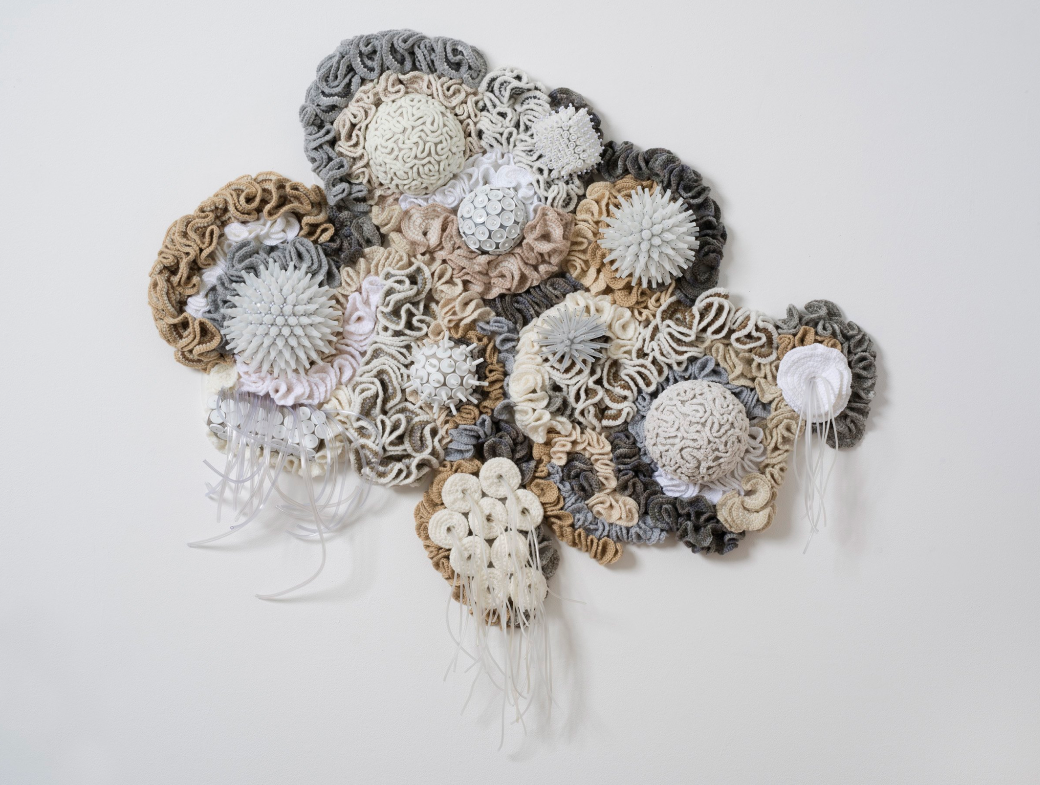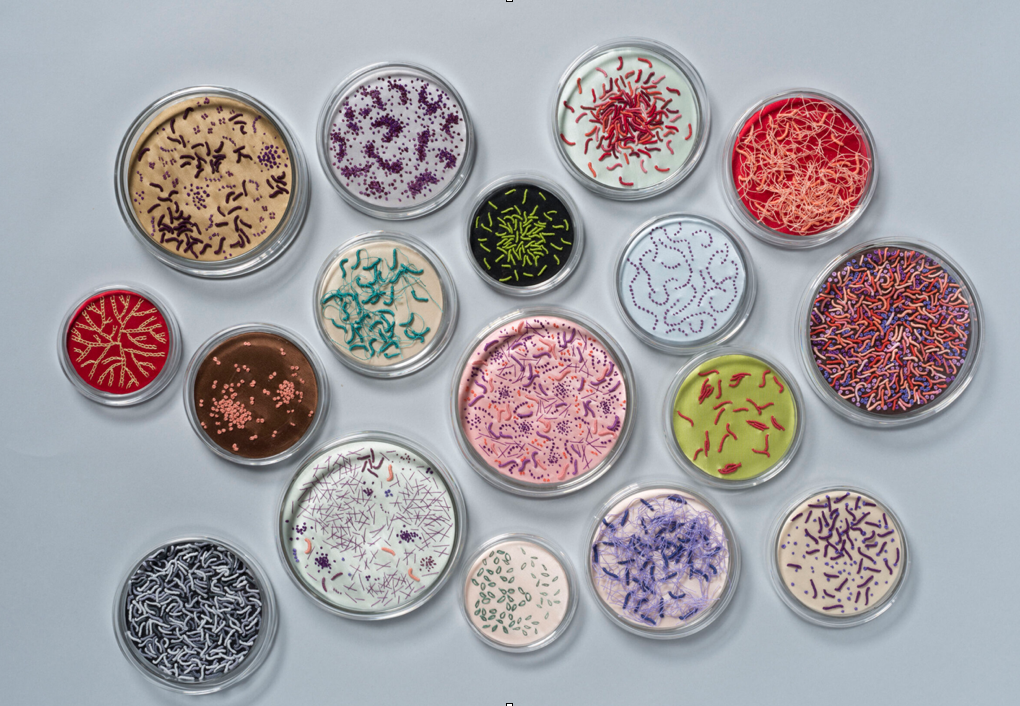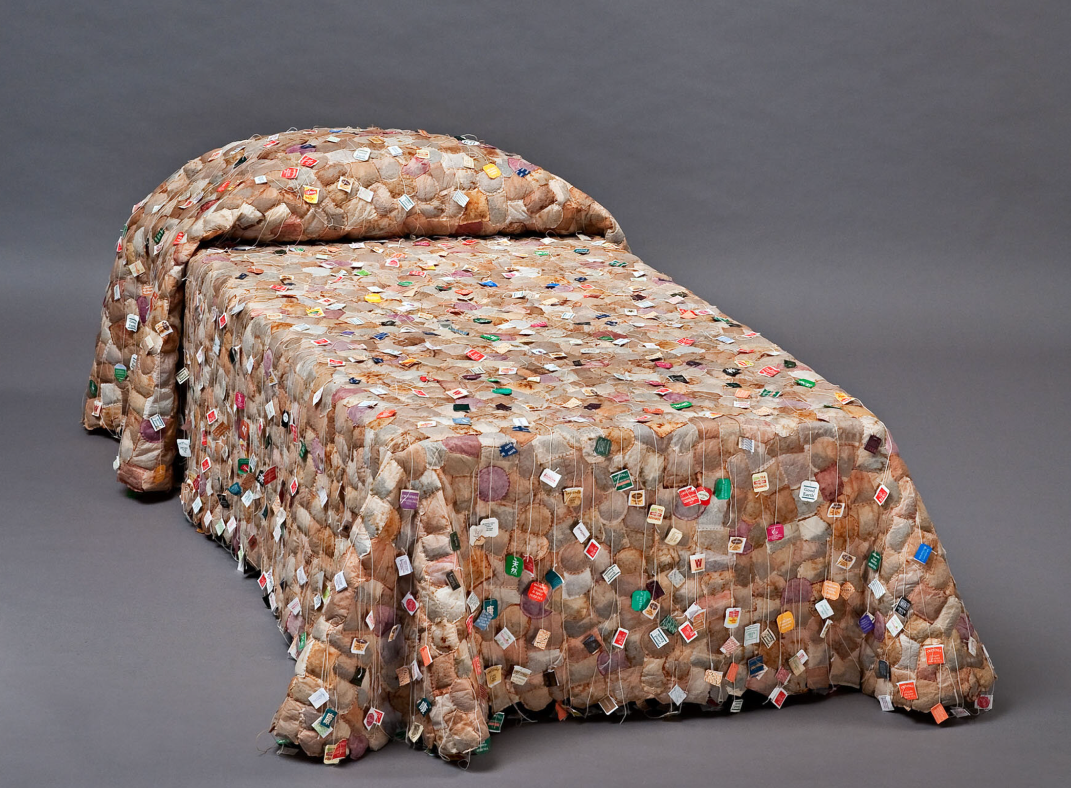
(Bleached, 2022. Crochet, assemblage. Acrylic, wool, bamboo yarns; plastic medical waste (needle caps, needle sheaths, vial caps, tubing caps, oxygen tubing, nasal prong tubing), polystyrene, pins. 36” x 40” x 6”)
Member Interview
By Olivia Ann Carye Hallstein
Ruth Tabancay is redefining the meaning of renaissance artistry as both a scientist and a textile artist dedicated to environmental awareness work. Using objects that largely exist in excess in her life (used tea bags, plastic medical waste, Styrofoam) she seamlessly blends traditions in textiles while heightening topics in microbiology. From plastic eating micro-organisms to tender memories and ocean impacts, Ruth’s work is multi-facetted and intriguing. The works Bleached, Adapting to New Substrates 2.1, and Adapting to New Substrates 3.0 will be part of the group exhibition A World Free of Plastic Imagined at Ruth's Table, 3160 21st Street, San Francisco, June 9-August 26, 2022. Reception Thursday, June 9, 6-8 pm. www.ruthstable.org

What’s In You and On You Normal Flora and Pathogens 1.2, 2019, Hand embroidery, fabric, embroidery floss, glass Petri dishes, 1 x 28 x 20 inches
Ruth, you create this amazing combination of textile traditions with contemporary issues, materials and sciences. What led you to work in textiles and how have your material and technique decisions informed your work?
As a teenager, I taught myself a variety of textile techniques—machine sewing, embroidery, crochet, knitting, needlepoint— and when I attended California College of the Arts I added weaving, felting, printing, basketry, and others to my collection of methods. I’m comfortable working with fiber materials as I’ve worked with them most of my life. I’m drawn to the tactility of unworked linear fiber materials such as yarn and wire and to objects such as tea bags, needle caps, or plastic bags that carry an intrinsic message. Thinking of their provenance or their future gives me a place to start an idea. When I latch onto a concept, I try to think of a way to impart the idea with materials rather than an exact representation of it. I draw on my inventory of techniques to see what most conveys that meaning.

Adapting to New Substrates 2.1, 2021, Hand embroidery on various plastics, 32 x 42 x 2 inches
And that inventory is vast! In your embroidery work, you integrate your interest in microbiology to display various bacteria that are usually unseen. In “New Substrates” you are displaying bacterial strains on plastics. How are you using your knowledge of microbiology to infer this evolution toward plastic dissolution? How much is science and how much is fantasy?
I majored in bacteriology in college and worked in hospital laboratories before going to medical school, so I’ve spent years looking at micro-organisms and learning their diseases. These microscopic forms and arrangements are embedded in my subconscious. In 2015, I started embroidering stitches that resembled micro-organisms as seen through a microscope onto fabric. In my embroidered series set in Petri dishes, What’s In You and On You: Normal Flora and Pathogens, I refer to the colors of stains, agar media, diagnostic tests and light fields that are actually used in the lab to inform my embroidery floss and fabric colors. I first began embroidering on polystyrene meat trays (commonly referred to as Styrofoam) in 2017 after reading that the gut bacteria of waxworms could digest polystyrene. More research along these lines is taking place in laboratories around the world. Since micro-organisms need substrate to grow on, such as different types of agar media in the lab, I extrapolated that polystyrene, or any kind of plastic could be possible. Though practical use of this research seemed far away, in April 2022 it was reported in Nature that researchers have found an enzyme variant that can break down plastic in hours to days rather than years. This finding gets us closer to actual usage. For my Adapting to New Substrates series, since the premise of organisms digesting plastic on the global scale is not yet a feasible reality, I embroider actual fungal structures such as branching septate hyphae or mycelia as well as larvae, bacteria, fungal spores and colonies. In my fantasy, the organisms could take on the color of the plastic they are living on or a completely new one.

Devour III, 2017, Hand embroidery, foam meat tray, embroidery floss, 5 3/4 x 8 1/4 x 1 inches
I am glad you mentioned the Styrofoam since your work extends beyond traditional fiber materials and into sugars, tea bags and plastics. Yet, when you use these materials, you hold true to practices in quilting or molecular structures. How do you balance tradition, reality, fantasy and avant-garde?
I can trace many of my works back to traditional craft—hand embroidery, hand quilting, crochet, the geometry of traditional patterns, fabric manipulation—but I apply modern concepts and personal experience to my work to add intent. Even my work with the scanning electron microscope and computerized Jacquard loom refers to traditional weave structures, both in the fabrics I scan and how I weave them. Concept is foremost and executing it in a fiber technique is my challenge to creating my artwork. Tradition, reality, and fantasy blend seamlessly together. The work with which I’m most satisfied contains very personal references. My tea bag bed quilt speaks of the times spent with my daughter snuggled in comforters, drinking tea, and doing her geometry homework. The accumulation of tea bags on the windowsill lead to Extending the Useful Life. My piece, Bleached, about the bleaching of the coral reefs, is composed of hyperbolic crochet, a structure seen in corals, sea slugs, lettuces, and cacti, and plastic medical waste. I was diagnosed with a progressive lung disease 10 years ago and 3 years ago, my lung function deteriorated to the point that I needed, and was fortunate to receive, a lung transplant. I have been collecting plastic medical waste for years knowing it would end up in my artwork. I created fantasy coral reef organisms out of vial caps, needle caps, needle sheaths, oxygen tubing, and tubing caps. This work creates personal conflict because I know one of the main causes of coral bleaching is the rise in ocean temperature. The burning of fossil fuels and, in my case, the manufacture of plastic medical waste contribute to this. But I have depended on medications delivered via these plastic objects to keep me alive. It distresses me to know that my personal needs add to this problem.

Extending the Useful Life, 2010. Hand stitched, tea bags, embroidery floss, muslin, batting, 26 x 33 x 65 inches
Thank you so much for a wonderful interview, Ruth!